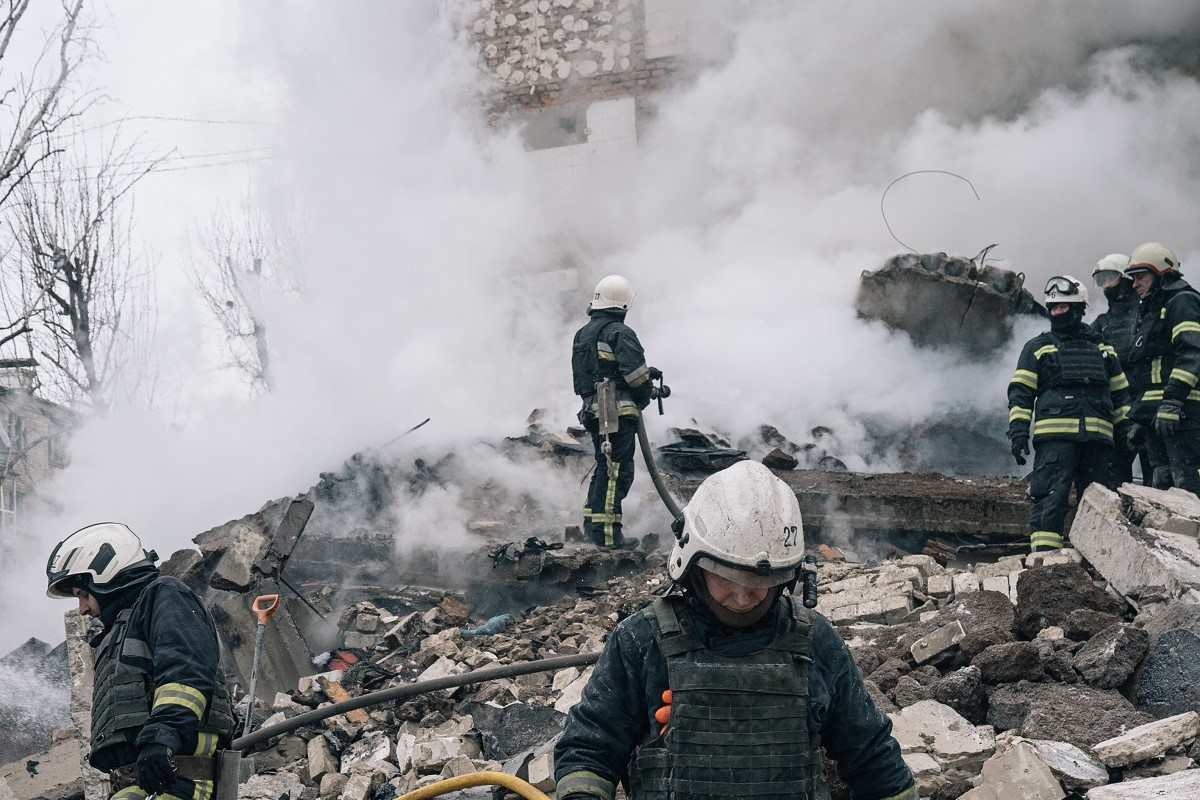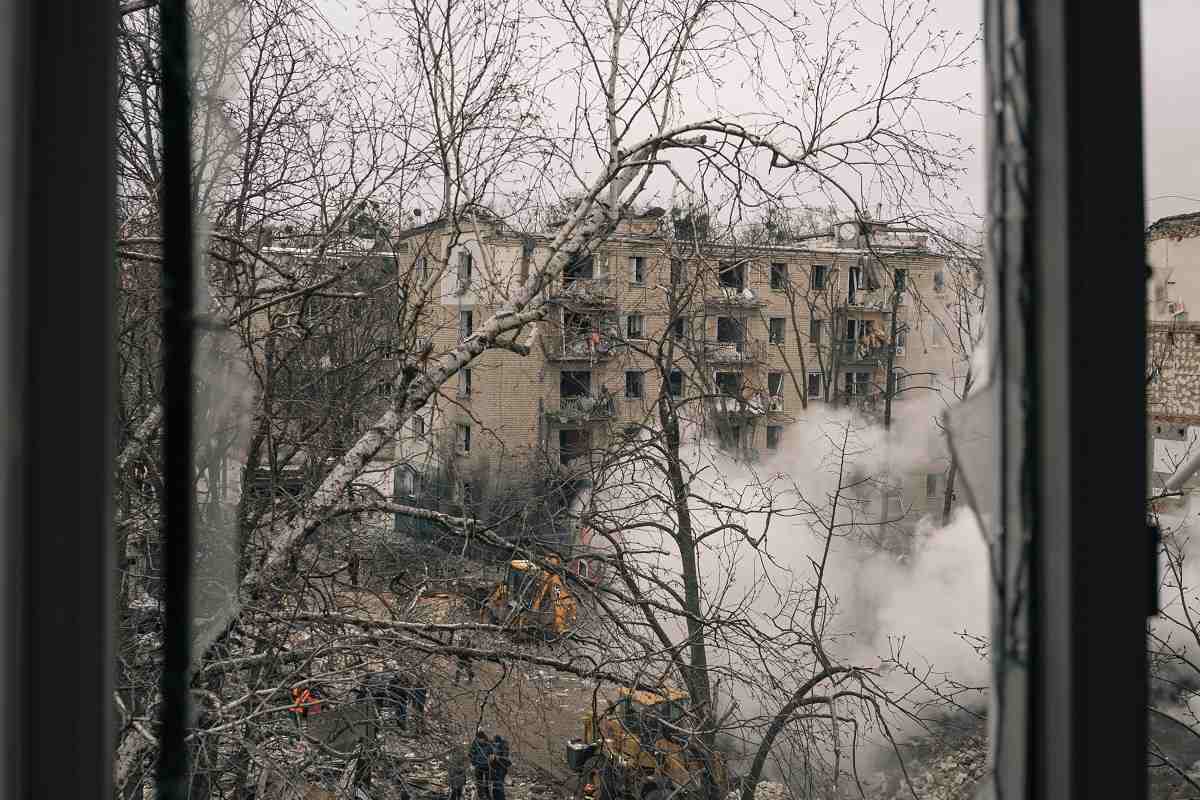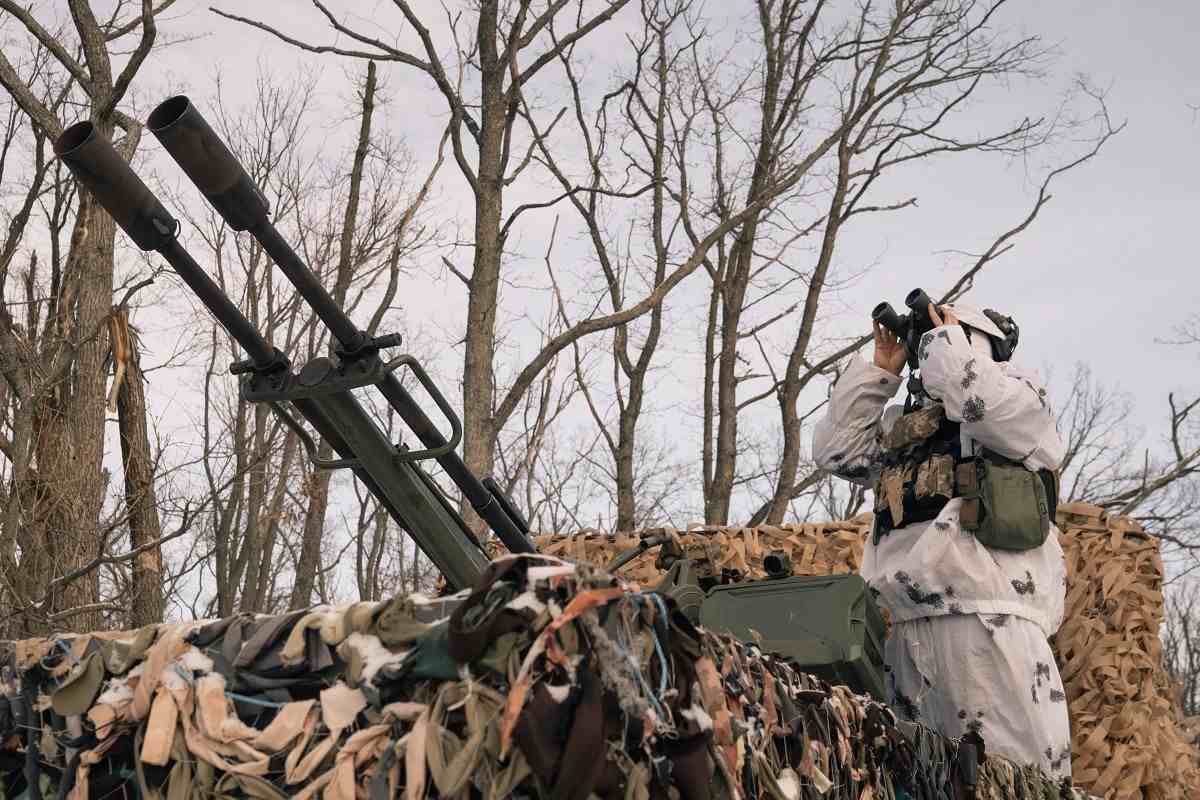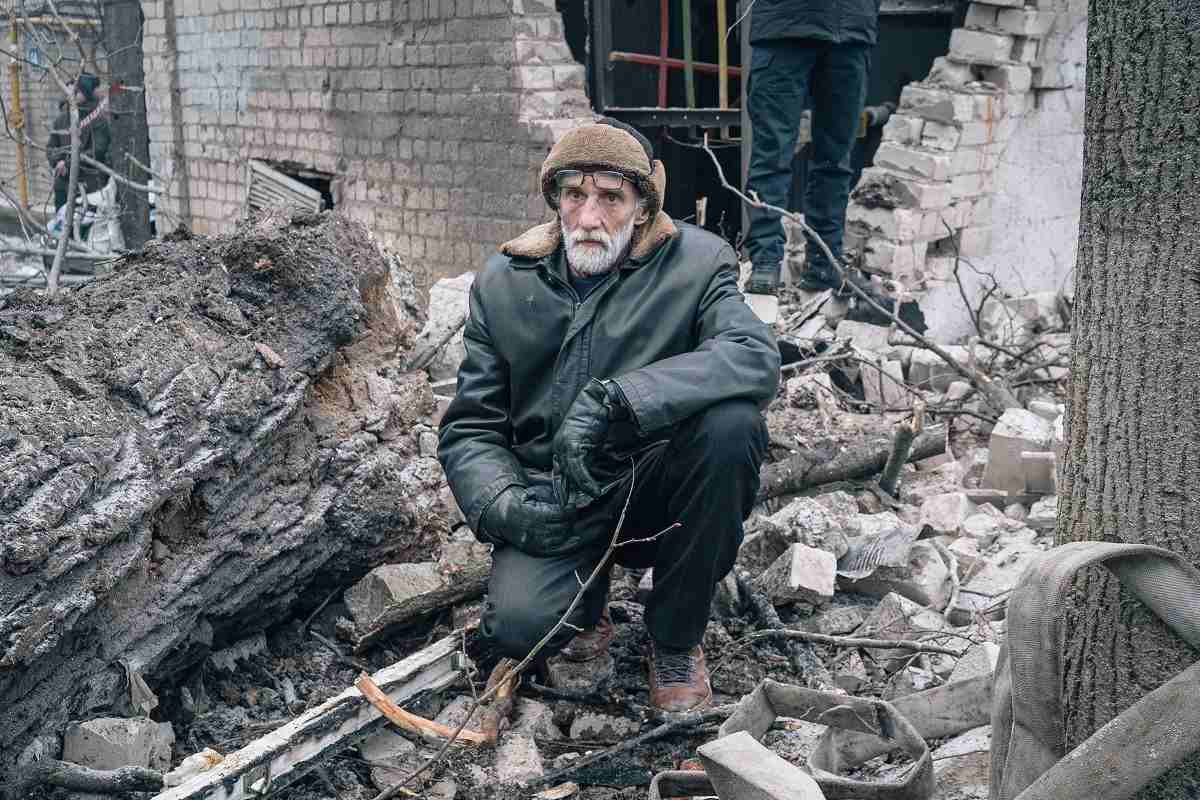
Rescuers search for survivors after a missile strike that destroyed a residential building in Kharkiv, Ukraine, on Tuesday.
13:41 JST, February 1, 2024
NORTH OF KHARKIV, Ukraine – The 59-year-old air defense unit soldier had just started his shift in a patch of snowy woods near the Russian border early Tuesday when a bright light blazed across the horizon.
He grabbed his radio and barked an urgent message: “I see flashes and hear outgoing booms!”
The soldier knew they were ballistic missiles, launched from inside Russia. But there was no time to stop them – and no weapon in his unit’s arsenal that could.
Seconds later, the missiles crashed into Kharkiv, Ukraine’s second-largest city, flattening a residential building and destroying other civilian infrastructure. Ten people, including a child, were killed, and dozens of others were wounded. Some victims were trapped for hours under the rubble.
“I understood they would fly and hit people, and that I couldn’t do anything to prevent it from happening,” said the soldier, who spoke on the condition that he be identified by his call sign, Grandpa, in keeping with military rules. The pain of that helplessness, he said, was a feeling he “couldn’t express in words.”

The aftermath of a missile strike on a residential building in Kharkiv on Tuesday.
Russia hit Kharkiv, which sits just 19 miles south of the border, three times on Tuesday: first at 4 a.m., then just after 7 a.m., and again close to 10 p.m. Twice, the city’s air raid siren warning civilians to take shelter went off only after the explosions had begun.
The barrages, which Ukraine said were combined attacks launched in part from S-300 systems inside Russia, were the latest in a series of recent strikes that appear aimed in part to exploit weak points in Ukraine’s air defense systems. The second of Tuesday’s three salvos, which Grandpa witnessed during his shift, was a combined attack that also hit Kyiv and the southeastern Dnipro region.
The missile strikes show that Russian President Vladimir Putin is prepared to destroy Ukraine rather than allow the country to pursue an independent, democratic future in the European Union. They also show that Ukraine still does not have enough air defenses even after the West supplied Kyiv with an array of systems including NASAMS, Iris-Ts, Gepards, Stingers and more.
The use of such systems came under scrutiny Wednesday, after Russia accused Ukraine of shooting down a military transport airplane in nearby Belgorod, which Moscow said was carrying dozens of Ukrainian prisoners of war. Ukraine has not denied downing the plane but officials said they had not confirmed that POWs were on board.
For Russia, Kharkiv makes for one of the easiest targets. The city is so close to the border that even modern air defense systems like the American-designed Patriot, which Ukraine uses in Kyiv, would struggle to respond in time to high-speed missiles moving on a ballistic trajectory. The proximity to Russia’s launch sites means the time between launch and landing typically is less than one minute.
Grandpa belongs to the 113th Territorial Defense Brigade, in a unit tasked with protecting the skies north of Kharkiv city. To do so, his unit relies on a Soviet-era ZU-23-2, a trophy weapon seized from Russian troops who left it behind when they retreated from the nearby city of Kupyansk in September 2022.
The mobile system, which is mounted to the back of a truck, can strike only targets that travel below the speed of sound. These include the growing number of drones launched each day from Russia, such as Iranian-made Shaheds and explosive FPVs, or first-person-view drones. Some of those weapons are aimed at troops stationed north of the city, an area Russia stormed and occupied early in 2022. Others target Kharkiv itself, which Russia never managed to seize.
Recently, however, Moscow seems to have set its sights once again on Kharkiv and the surrounding region, which it abandoned during Ukraine’s lightning-fast counteroffensive in September 2022.
Makhno, 38, commander of the air defense unit, said that in the past month, a growing number of diversion groups – made up of five to 20 Russian troops at a time – have crossed the border into Ukraine to stoke fear in border communities and seize prisoners who might have information about Ukrainian troop movements and shift changes.
Russian forces have also struck the city repeatedly while reinforcing their troop positions from other angles, including east of Kupyansk. In the past four weeks alone, missile strikes in Kharkiv destroyed two hotels and damaged hundreds of buildings. The first strike on Tuesday also hit a gas pipeline and a school. Attacks like these are why students who attend school in person in this city now do so in makeshift classrooms built in train stations underground.
“We have a lot of fear and anxiety,” said Larisa Kulakova, the main preschool education specialist in Kharkiv. “The city is getting shelled more and more.”
On Tuesday afternoon, at a military position between Kharkiv and the border, troops in the brigade’s air defense unit – dressed in white snowsuits to blend in with the wintry landscape – paced around, preparing to respond to more incoming strikes. One stood in the bed of the truck, peering through binoculars for incoming drones and missiles.
“The position is constantly tense,” said Makhno, whose call sign is a nod to a famous Ukrainian revolutionary who died in 1934.

A member of a Ukrainian air defense unit in the back of a truck with a mounted ZU-23-2 north of Kharkiv on Tuesday.
Delays in arms deliveries from partners in Europe and the United States, he said, have put his troops – who have fought in eastern Ukraine since 2014 – on the back foot. “The world is wasting time deciding ‘should we give them weapons, should we not?’” Makhno said. “We need to be two steps ahead of the enemy.”
Another soldier, who goes by the call sign Strilok, or Shooter, said that when missiles are headed for the city, “we definitely feel we can’t do anything.” The best way to stop the strikes, he said, would be to use a U.S. High Mobility Artillery Rocket System, or HIMARS, to hit the launch sites in Russia. But Washington, which provided the systems, has barred Ukraine from using them to hit targets within Russia – a limitation Strilok called “absurd.”
As Makhno’s troops scanned the sky, rescue workers just down the road in Kharkiv waded through the remains of the apartment complex a missile hit that morning. Anxious friends and relatives of the missing stood by, hoping for miracles in subfreezing temperatures and clouds of smoke.
In neighboring apartment blocks, survivors dragged their belongings out of their shattered homes as volunteers arrived to help board up their windows. Sasha Terekhovich, 33, woke up to the first round of strikes on Tuesday and moved from her bedroom to her living room couch – a decision she said saved her life. One of the missiles from the next round crashed into the building next to her, blowing all her windows into her home.
“In Kharkiv, if something is headed here, it’s going to hit,” she said.

Sasha Terekhovich narrowly survived an airstrike in Kharkiv.
Around 12:30 on Tuesday, a 60-year-old man named Viacheslav sat crouched outside the wreckage of the apartment block, waiting for news about relatives. His wife’s ex-husband, Valera, and Valera’s wife, Yulia, lived on the first floor. The two couples are close; they share children and grandchildren. For the first 17 minutes after the strike, they could see that Valera and Yulia’s phone numbers still appeared as “online” on messaging apps. Then they disconnected.
Hours passed with no news. Viacheslav’s stepson checked nearby hospitals for his father, with no luck. Viacheslav’s wife called for an update. “They’re digging through the rubble,” he told her.
Hours later, workers pulled a body out of the wreckage and placed it in a black plastic bag. Relatives of the missing gathered around. One woman, searching for friends from the fourth floor, held a lock of hair and an earring, as potential clues. Another woman, in a red hat and jacket, told a police officer that her daughter and granddaughter were still missing. She described them, and he took her information to connect her with the morgue.

Viacheslav waits for news about his extended family.
The body in the bag was a woman, the officer, Maxim Melnychenko, 43, said. “She was boiled,” he said. “We couldn’t show them her face because it’s too disturbing.”
As dusk set in, rescue workers, who had gently sifted through debris to look for survivors earlier, began digging more aggressively. Hours later, powerful explosions struck the city again. More civilians were wounded. More rescue workers rushed to the scene.
Again, the air defense unit north of the city saw the missiles headed to Kharkiv. Again, there was nothing they could do.
"News Services" POPULAR ARTICLE
-

American Playwright Jeremy O. Harris Arrested in Japan on Alleged Drug Smuggling
-

Japan’s Nikkei Stock Average as JGB Yields, Yen Rise on Rate-Hike Bets
-

Japan’s Nikkei Stock Average Licks Wounds after Selloff Sparked by BOJ Hike Bets (UPDATE 1)
-

Japanese Bond Yields Zoom, Stocks Slide as Rate Hike Looms
-

Japan’s Nikkei Stock Average Buoyed by Stable Yen; SoftBank’s Slide Caps Gains (UPDATE 1)
JN ACCESS RANKING
-

Keidanren Chairman Yoshinobu Tsutsui Visits Kashiwazaki-Kariwa Nuclear Power Plant; Inspects New Emergency Safety System
-

Imports of Rare Earths from China Facing Delays, May Be Caused by Deterioration of Japan-China Relations
-

University of Tokyo Professor Discusses Japanese Economic Security in Interview Ahead of Forum
-

Japan Pulls out of Vietnam Nuclear Project, Complicating Hanoi’s Power Plans
-

Govt Aims to Expand NISA Program Lineup, Abolish Age Restriction



















